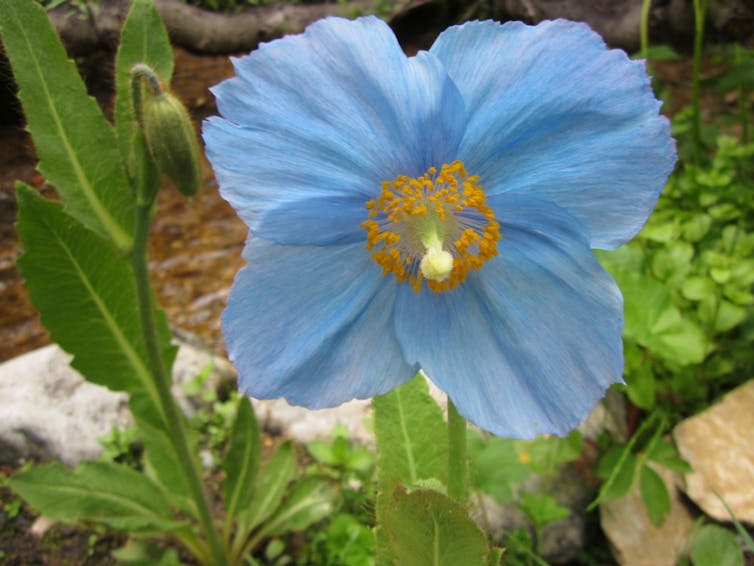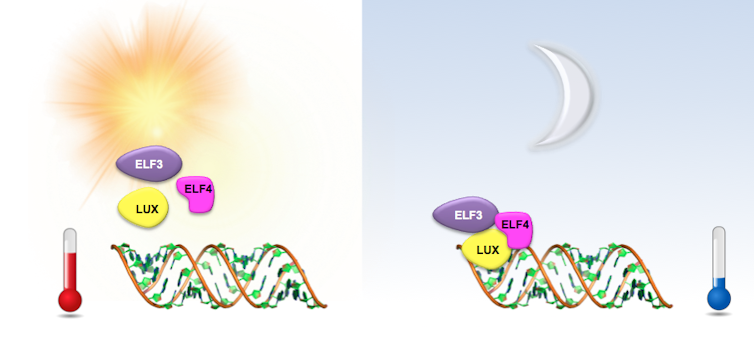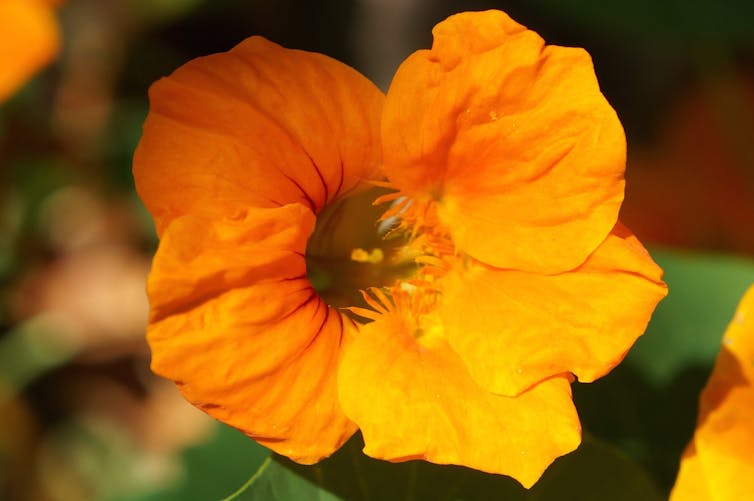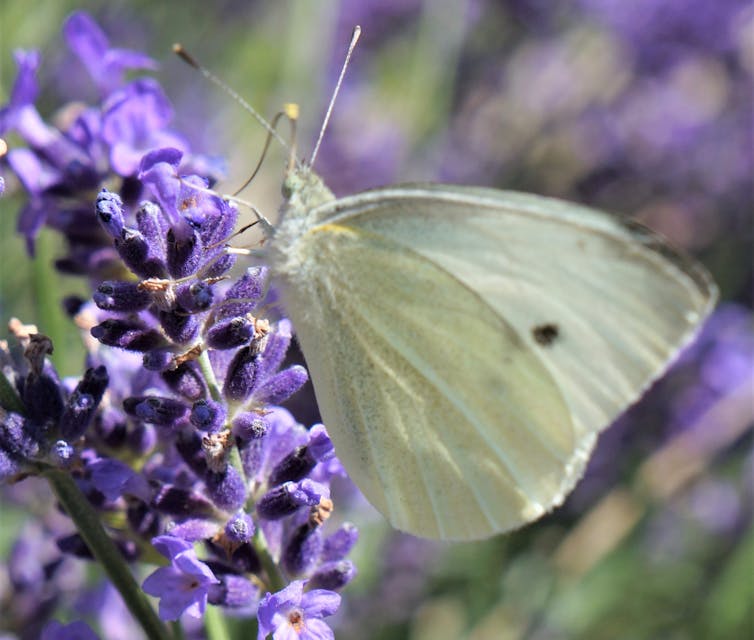After a long winter, the days are getting longer and the temperatures are starting to rise. Almost overnight, plants awaken from their winter dormancy and explode into bloom. But how do plants perceive this change of season?
Two main factors, light and temperature, interact to cause this transition. These factors alter plant development by modulating their circadian clock – the internal chronometer that helps plants anticipate daily and seasonal changes.
An internal clock in plants as in humans
In humans, the circadian clock regulates sleep-wake cycles, metabolism, hormone levels, and even body temperature. This is why we experience “jet lag” when we change time zones – our 24-hour biological clock needs to be reset.
In plants, the circadian clock controls enzyme activity , leaf movement, and many growth and development processes, including reproduction, flower opening, and scent production. The circadian clock helps the plant know what the season is and when to flower for successful reproduction.
The circadian clock is present in most organisms and gives rise to oscillations in gene expression that repeat over approximately 24 hours: an organism's genes function as a set of detailed instructions that are used to make all the proteins in a cell to ensure growth and development.
Bloom now or later?
The plant must balance different variables – light quality, day length, temperature, water and nutrient levels, and pollinator availability – in order to time the floral transition, that is, the change from vegetative to reproductive growth. The timing of flowering is crucial because the flower, with its showy petals, its stamens, its male organs that produce pollen, and its carpels, the female organs that produce fruits and seeds, is a delicate and easily damaged structure.

If the plant flowers too early in the season there is a risk of chilling injury or insufficient biomass to support many flowers and if it flowers too late in the season the plant cannot complete its reproductive cycle. However, as average winter temperatures rise due to global warming, plants are flowering earlier and earlier in the season. One of the actors of this early flowering is the evening complex, a powerful repressor of growth and flowering.
The "evening complex", the great conductor of flowering
The “evening complex” is an essential part of the circadian clock of plants. As its name suggests, it is active at night and controls many genes that are important for the functioning of the circadian clock and the development of the plant. The evening complex is made up of three different proteins, which interact with each other, forming an active complex that suppresses growth and flowering genes.
Proteins are produced in plant cells at dusk, the complex forms and binds to DNA in each cell that expresses the complex, resulting in 'suppressed' plant growth overnight. During the day, the proteins in the complex are no longer expressed, and the genes that are inhibited during the night can be fully expressed, and induce plant growth. In the evening, the three evening complex proteins are produced again, continuing the 24-hour clock cycle.

In addition to regulating the circadian clock, the evening complex also acts as a temperature sensor, adjusting clock function and plant development to warmer or cooler conditions.
Evening Complex can sense small temperature changes of a few degrees and alter plant growth accordingly. The evening complex is able to bind DNA at lower temperatures, around 15℃ to 20℃, but when the temperature rises, it is no longer able to assemble onto DNA as an active complex. As a result, genes important for growth and development stay "on" even at night in hot weather, accelerating growth and causing early flowering.
How it works ?
The evening complex inhibits in particular the action of a key protein in growth and flowering. At too high temperatures, the evening complex is not able to inhibit this protein. This can therefore give the main signal that tells plants to flower, by activating the expression of the flowering gene, florigen .
In order to understand how the evening complex fulfills its functions in circadian regulation and temperature sensing, we studied how it forms, how it recognizes DNA at the molecular level, and how it acts on it.
We have discovered the subtle ballet between the three proteins of the evening complex: only one of the three proteins, "LUX", binds directly to DNA thanks to a particular sequence of amino acids, which folds into a three-dimensional structure capable of recognizing a specific DNA sequence in the genome of the plant. This protein joins the other two close to the DNA.
Using X-rays at the Grenoble synchrotron , we have determined the three-dimensional structure of LUX when bound to DNA. It is thanks to its specific three-dimensional structure that LUX is able to find and recognize a very specific short DNA sequence, consisting of 6 base pairs, in a genome containing 135,000,000 base pairs.
Like pieces of a puzzle, LUX and the other two proteins assemble around this specific sequence and prevent the expression of neighboring genes. In fact, the two recruited proteins have different functions: one decreases the ability of LUX to bind to DNA, while the other restores the interaction with DNA, all as a function of temperature.

We modified the amino acid sequence of LUX to decrease the binding of the evening complex to DNA. This mutation allowed the plants to grow faster and flower earlier, even at lower temperatures. This strongly indicates that the evening complex can be made more or less active by altering the binding strength between LUX and DNA. The challenge now is to design a mutation that will increase the binding stability between the LUX protein and DNA even at high temperatures, resulting in a more active evening complex and plants less sensitive to warmer temperatures.
Why is it so important to understand the molecular mechanisms of temperature sensing?
Many crop plants exhibit "thermomorphogenesis", which means that temperature alters the architecture, development and growth of plants. Early flowering is one of the most striking consequences of higher growing temperatures and may ultimately lead to a decrease in biomass, seed count or smaller fruits.

Plants have evolved with their environment over millennia, optimizing their chances of survival through the successful production of viable seeds. Due to climate change, the delicate balance between sufficient light and high enough temperature for optimal growth is being altered faster than plants can adapt, meaning we face uncertain food security.
Understanding how temperature signals are perceived by the circadian clock of plants opens the possibility of modifying their response to environmental changes. If we can make the evening complex bind DNA better, we could slow down the internal clock of plants, in order to adjust growth and entry into reproduction to warmer conditions. ![]()
Stephanie Hutin , Researcher, Grenoble Alpes University (UGA) and Chloe Zubieta , CNRS Research Director, Atomic Energy and Alternative Energies Commission (CEA)
This article is republished from The Conversation under a Creative Commons license. Read the original article .
